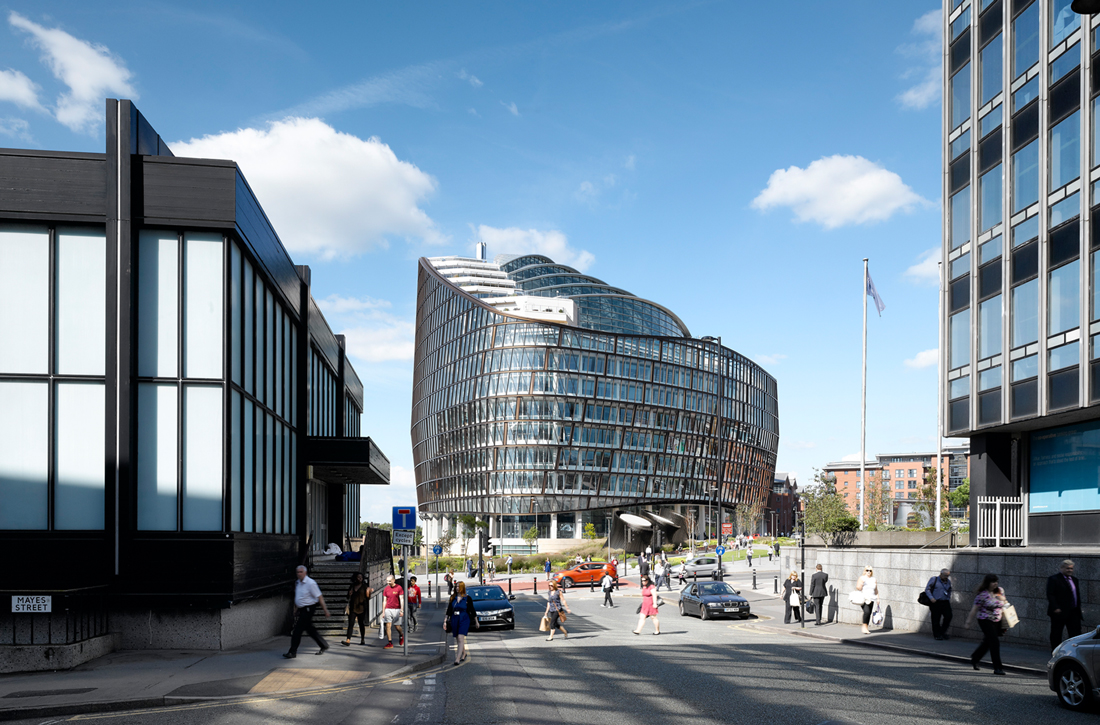 © FPA_Jack_Hobhouse
© FPA_Jack_Hobhouse
PROJECT INFO
Building type:
Offices
Year:
2019
Project Status:
Built
Gross Area:
31248 Sqm
Certificates:
BREEAM New Construction 2014 (UK) Excellent
Climatic zone:
Temperate
MY LAST SEEN PROJECTS
PROJECT DESCRIPTION
There can be few areas in London where so many engineering landmarks rub shoulders. Derwent London’s Brunel Building, a 17-storey new-build workplace building designed by Fletcher Priest, overlooks the Grand Union Canal and Paddington Station, the London terminus to Isambard Kingdom Brunel’s Great Western Railway, and is next to the site of Brunel’s first ever bridge. The elevated A40 expressway runs past and the Elizabeth Line, the new cross-London railway, stops near-by. One hundred-year-old cast-iron subway tunnels run beneath the site.
This unique and evocative context sets the tone for the design of Brunel Building. The brief called for a development with innovative workspace which would attract occupiers, as well as highlighting the significance and amenity of the area. “We agreed that the design demanded a robust construction which would embody the spirit of the great engineer Brunel”, explains Derwent’s Simon Silver.
The solution was also technically driven by the presence of the canal and two Bakerloo Line underground tunnels running across one corner of the site. Working with Arup, Fletcher Priest’s proposal for a steel diagrid exoskeleton refers to Brunel’s now lost Great Western Railway viaducts. It is not only visually arresting but allows the building to span the tube lines. The building is pulled back at this corner to reduce loading, while a line of piles between the two tunnels helps to distribute foundation loads.
Pushing the superstructure to the outside of the 32,912 sqm building delivers column-free internal floor space – spanning 12-16m to the dispersed central cores and 66m from end to end. Occupiers can have maximum flexibility with their fit-outs and enjoy unimpeded views.
The external structure shades windows, allowing larger areas of glazing and deep daylight penetration. Beams are tapered as they approach the facade, permitting the use of taller perimeter glazing and further increasing daylight. This impression of light and space is further enhanced by the high floor-to-ceiling dimensions. Fletcher Priest and Arup worked with building services engineer Cundall to integrate the floor structure and services into as tight a zone as possible, some 100mm less than normal for workplace buildings, to further increase ceiling heights.
“Building services have been left on display throughout, to reveal how the building has been constructed. This strategy is most emphatically revealed through the exposed external structure, while vibrant orange, inspired by waterside safety equipment, was chosen to highlight mechanical and structural elements and canal-side public lifts”, says Fletcher Priest partner, Keith Priest.
This aesthetic means that materials such as concrete, steel and sawn oak have been left exposed internally, and service ducts and pipes are visible. Extra emphasis has been put on the quality of construction - a particular challenge in areas such as the core, where huge areas of concrete required a consistent finish, and had to remain protected during construction. Extensive full-scale physical mock-ups and integrated digital modelling became key design tools.
AWARDS
SUSTAINABILITY FEATURES
Innovative cooling system
High efficient façade
Grey Water Recycling
Sustainable building materials
Reclaimed materials
Smart design (passive design strategies)
Thermal energy storage (i.e. water, ice, PCM)
Ground Source Heat Pump
Daylighting maximised
Waste reduction commitment
SUSTAINABILITY STRATEGY
Environment and social sustainability were central to the ambitions of both design team and client.
The existing building on the site spanned this section of the canal blocking access and views along the canal. The canal-side walk is now publicly accessible for the first time in more than 200 years and will eventually provide new pedestrian routes to nearby Little Venice, as well as a new public space and artwork. Brunel Building is one of surprisingly few canal-side developments in London with its main entrance on a canal.
Motorized hangar-sized glazed sliding doors can be rolled back to provide an extension to the new tree-lined towpath walkway. Passers-by can visit the canal-side restaurant café and bar and view the public art in the triple-height reception concourse. Meanwhile, occupiers have access to two expansive roof terraces with views across London. Soft landscaping, planters with wildflowers, trees and nesting boxes all contribute toward re-establishing the local ecology in what was previously a light-industrial area.
DIGITAL DESIGN TOOLS
Such a rich and complex building, which took three years to construct, could only be delivered by harnessing the latest digital tools, developing and coordinating the design, and managing the logistics for fabrication and construction. “We could visualise the design via simulated walkthroughs and virtual reality headsets, enabling the architects, designers and suppliers to check for clashes, such as pipework running through beams, so we could make and assess changes holistically,” says Fletcher Priest associate Chris Radley.
SUSTAINABLE BUILDING MATERIALS
A sustainable procurement policy was in place during construction which included requirements for: responsibly sourced materials, materials with a high recycled content, regional materials and waste minimisation and recycling.
- All indoor finishes are carefully chosen in order to enhance people’s health and wellbeing in the building while minimising the environmental impact of the building materials. Indoor finishes with very low or zero volatile organic compound emissions are adopted. Using sustainable materials positively impacts the life cycle costs. - The use of glass panels with recyclable composite material, for example, reduces the costs for replacement and maintenance.
- Recycled and ground blast-furnace slag (a waste product from iron and steel production) was used in the concrete.
- More than 98% of construction waste was recycled.
- Aluminium used in the façade contained 65% recycled content.
OPERATIONAL ENERGY AND EMBODIED CARBON
- Operational and embodied carbon assessments were completed during the early stages of the project to identify opportunities for reducing carbon emissions throughout the design process.
The building's operational energy consumption is reduced by 71% over the energy benchmark of a typical Econ19 office fit out.
Leaving the ceilings exposed also saved more than 540 tonnes of embodied carbon.
PASSIVE AND ACTIVE STRATEGIES
- The complex external diagrid structure provides 20% shading to the facades, helping to reduce energy demand.
- Exposed undersides of the structural precast concrete floor panels, made in a state-of-the-art robotic plant, help to deliver comfortable interior thermal gradients and more volume per person. This provides the indoor spaces with an adequate amount of exposed thermal mass that improves occupancy comfort during heat wave conditions. Exposing the structure both internally and externally helped to reduce embodied carbon. Avoiding suspended ceilings saved 540 tCO2e, fly ash replacement in the concrete saved over 1,000 tCO2e and employing self-finishing concrete saved 18 tCO2.
- The building is provide with an aquifer thermal energy storage (ATES) system that utilises two 180m-deep boreholes to take advance of the stable ground temperatures.
- In order to improve energy consumption and comfort, low energy fan coil units can be individually controlled.
WATER CONSERVATION
- Grey water from showers is recycled to flush the building’s bathrooms.
All workspace was oversubscribed long before completion, Brunel is the new home to a remarkably diverse ecology from many sectors; Sony Pictures, the Premier League, Alpha FX, Splunk, Hellman & Friedman, Coach and Paymentsense.
ENERGY DATA
Energy consumption:
N/A (N/A )
Consumption type:
Annual carbon footprint:
N/A (N/A )
Climate zone:
Temperate
Min. temperature =
N/A
Max temperature =
N/A
RH =
N/A

CLIENT
Client:
Derwent London
DESIGNERS
Architect:
Architect:
CONSULTANTS
Cost consultant:
Arcadis
Manager:
Gardiner & Theobald
Specialist consultant:
Plincke / Barton Willmore , Jackson Coles / HCD , MLM
Structural Engineer:
ARUP
CONTRACTORS
Contractor:
Laing O’Rourke
OTHER PROJECTS BY TEAM
SIMILAR PROJECTS

Avenida República do Chile - Centro, Rio - Rio de Janeiro, Brazil | 2013

.jpg)

.png)

Via Filippo Turati, 25, 20121 Milano, Italia | 2012

Via Energy Park, 20871 Torri Bianche MB, Italy | 2009


.jpg)
.jpg)



.jpg)
.jpg)

.jpg)
.jpg)
Seattle, WA, USA | 2012
.jpg)









Via Umberto Forti, 1, 56121 Montacchiello PI, Italia | 2016

.jpg)
Via Chiese, 72, 20126 Milano MI, Italia | 2018
.jpg)
Viale della Liberazione, 20124 Milano MI, Italia | 2017
.jpg)
Via Bernina, 12, 20159 Milano MI, Italia | 2012

.jpg)


New Cairo City, Cairo Governorate, Egypt | 2016




Parma, Province of Parma, Italy | 2018
.JPG)
.png)




Manhattan, New York, NY, USA | 2016

Via Fabio Filzi, 29, 20124 Milano MI, Italia | 2015

Piazza Tommaso Edison, 20123 Milano MI, Italia | 2017